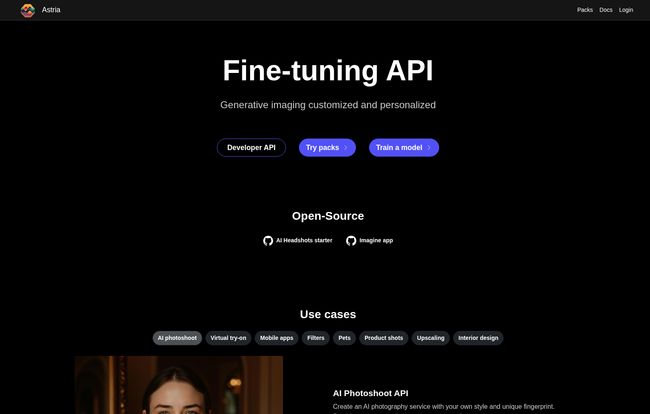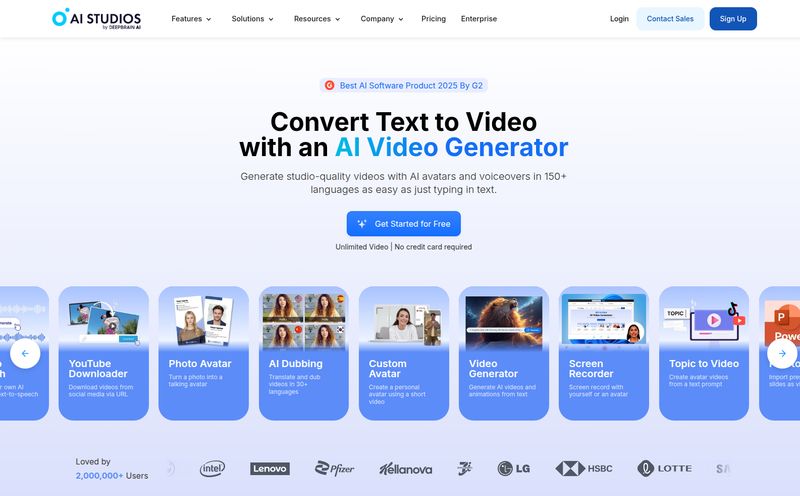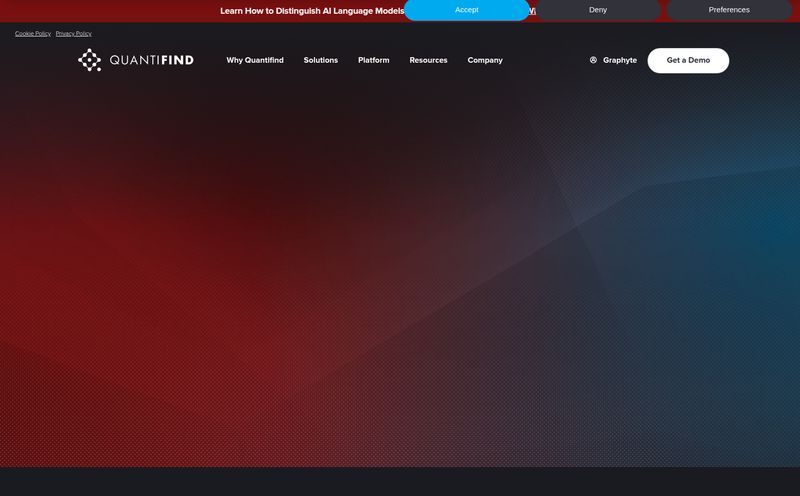The AI image space is getting… crowded. It feels like every week there's a new tool that promises to turn your half-baked thoughts into a digital masterpiece. And don't get me wrong, some of them are incredible. But after a while, you start to see the patterns. The same glossy sheen, the same slightly-off hands, the same look that screams "I was made by an AI."
I ran into this wall a few months back on a project. We needed a series of character portraits with a very specific, consistent art style. We tried prompt-crafting our hearts out on the usual platforms, but the results were all over the place. Close, but never quite right. It was frustrating.
That's when I started looking for something different. Not just another generator, but a tool that would let me teach the AI what I wanted. A tool for creators and developers. That's how I stumbled upon Astria. It’s not your average point-and-click image generator; it's something a whole lot more interesting.
What Exactly is Astria AI? (More Than Just Another Pretty Picture Generator)
So, what sets Astria apart from the sea of AI tools? Simple. It’s an API built for customization. Instead of just giving you access to a massive, pre-trained model, Astria gives you the power to create your own small, specialized models through a process called fine-tuning.
Think of it this way: most AI image tools give you a massively talented but generalist artist. You can describe what you want, but they'll always interpret it through their own style. Astria, on the other hand, lets you train a specialist. You can show it a set of images—your product, a person's face, a specific artistic vibe—and it learns. It creates a dedicated model that gets your unique concept.
It’s built on powerful tech like Dreambooth and supports models including the new Stability AI Flux model, plus the workhorses Stable Diffusion XL (SDXL) and 1.5. For developers, this is gold. It’s the difference between picking a stock photo and directing your own photoshoot.

Visit Astria
The Core Features That Make Astria Stand Out
When you get under the hood, a few things really pop. It’s not just one feature but how they work together that makes Astria a compelling choice for certain projects.
Fine-Tuning Your Vision
This is the heart of Astria. You can take a handful of images of a subject—say, 10-20 photos of a person or a product—and use them to fine-tune a model. The result is a unique model identifier that you can then use in your prompts. So instead of prompting for "a man with brown hair," you can prompt for "a photo of [your unique model name]," and it will generate images of that specific person. It’s incredibly powerful for creating consistent AI photoshoots, character designs, or branded imagery.
A Developer-First API
Here's something that made me breathe a sigh of relief: No devops required. The infrastructure is auto-scaling. In my experience, 'no devops' is one of the most beautiful phrases in the English language for a small team. You don't have to worry about spinning up servers or managing GPU instances. You make an API call to start a fine-tune, wait for it to finish, and then make API calls to generate images. This simplicity lowers the barrier to entry significantly. You can integrate custom AI image generation directly into your mobile app, website, or internal tools without becoming a machine learning engineer overnight.
Creative Tools Beyond the Basics
Astria also bundles in some handy post-production tools accessible via the API. Things like super-resolution to upscale your images, automatic face correction, and background removal are available. It’s a neat little toolkit that saves you from having to pipe your images through another service for these common tasks. Every little bit of workflow consolidation helps, right?
Real-World Applications That Actually Make Sense
Okay, the tech is cool, but what can you actually do with it? This is where theory meets traffic and conversions. I’ve seen some really smart applications for this kind of tech.
- AI Photoshoots: Imagine being able to generate hundreds of professional-quality headshots or lifestyle photos of yourself or a model, in any setting, wearing any outfit, all without a camera. This is a game-changer for personal branding and marketing content.
- Virtual Try-On: This is a massive one for ecommerce. A customer could upload a photo and see what your products look like on them. Astria's Flux model has a specific, and quite affordable, virtual try-on feature that could seriously boost conversion rates for apparel brands.
- Product Shots: Train a model on your product and then generate infinite lifestyle shots of it in various settings. No need to ship products to a dozen different locations for photoshoots. You can create an entire campaign from your desk. Its a huge time and money saver.
- Custom App Integrations: If you're building an app, you can let users create personalized avatars, generate unique game assets on the fly, or even create AI-powered design mockups for things like interior decorating.
Let's Talk Money. Breaking Down Astria's Pricing
Alright, let's get down to the brass tacks: what does all this cost? Astria’s pricing is à la carte, which is both a pro and a con. It’s great because you only pay for what you use, but you need to understand the components to predict your costs. Here’s my breakdown:
| Service | Cost | What it Means |
|---|---|---|
| AI Model Fine-Tune | $1.50 per tune | This is the cost to teach the AI your new concept (a face, product, style). It's a one-time fee per model you create. |
| Image Generation | $0.23 per prompt | After your model is trained, you use prompts to generate images. Each prompt gives you a batch of 8 images by default, so you're looking at about 2.8 cents per image. |
| Virtual Try-On (Flux) | 8.0 cents per image | A specialized, higher cost for the e-commerce try-on feature. |
| Add-ons | ~$0.01 - $0.0125 | Small fees for extras like Super Resolution, Face Correction, or Background Removal. |
| Extended Model Storage | $0.50 /model/month | This is a big one. Your fine-tuned models are deleted after 30 days unless you pay to keep them. |
My take? The pay-as-you-go model is fantastic for project-based work or startups that want to experiment without a hefty subscription. But for high-volume applications, you'll want to map out your expected usage. That 30-day model expiry is a critical planning factor!
The Not-So-Shiny Bits. What Are the Downsides?
No tool is perfect, and it's only fair to talk about the potential drawbacks. I believe in giving the full picture, not just the sales pitch.
First, fine-tuning takes time and compute power. It’s not instant. You submit a job and wait, which can take anywhere from 20 minutes to over an hour depending on the model and queue. This requires a more asynchronous workflow in your application.
The biggest gotcha for me is the 30-day model storage limit. If you don’t pay the $0.50 per month to store your model, it vanishes. For an ongoing project where you need to generate images of the same subject regularly, this storage fee is basically mandatory. You have to factor it into your operational costs.
Finally, for the hardcore Stable Diffusion power-users, Astria doesn't officially support using external checkpoints. The platform is designed as a more streamlined, managed environment. This is a trade-off: you give up some of the wild, open-source flexibility for the convenience of a system that just works. For most businesses, thats a trade worth making.
Answering Your Burning Questions About Astria
Is Astria good for beginners?
I'd say it's geared more towards developers or technically-inclined creators. If you're comfortable with basic API concepts, you'll be fine. If you're looking for a simple web interface to type a sentence and get a picture, tools like Midjourney might be a better starting point.
How is Astria different from Midjourney or DALL-E?
The key difference is customization and access. Midjourney and DALL-E are consumer-facing platforms where you use their giant, general-purpose models. Astria is a developer API that lets you build your own smaller, specialized models. It's an ingredient, not the final meal.
What is 'fine-tuning' in simple terms?
It’s like giving the AI a crash course on a new, specific subject. You show it a set of pictures of 'your dog, Fido,' and it learns what Fido looks like. From then on, you can ask for 'a picture of Fido on the moon,' and it knows exactly who Fido is.
Is the pricing cost-effective?
It depends entirely on your use case. For creating a few hundred high-value, custom images for a marketing campaign, it's incredibly cost-effective compared to a traditional photoshoot. For generating thousands of generic images daily, the costs could add up. You have to weigh it against the value of the customization.
How long does a fine-tuned model last?
It lasts for 30 days for free after it's created. After that, you'll need to pay a small fee of $0.50 per model per month to keep it active. Otherwise, it gets deleted.
My Final Take. Is Astria Worth Integrating?
After spending some quality time with the API, I can say with confidence who Astria is for. It’s for the developers, the startups, the creative agencies, and the e-commerce brands who have hit the limits of generic AI and need something more. It's for people who want to build unique visual experiences and integrate them directly into their products.
Who is it not for? The casual user who just wants to make a cool profile picture for social media. The tools for that are simpler and more direct.
Astria isn't a magic button, but it is a powerful workshop for those willing to build something tailored and specific. It hands you a level of control that's still rare in this space. And in the rapidly commodifying world of AI content, I've always felt that control is the new currency. If you need your AI images to be truly yours, Astria is absolutely worth a look.



